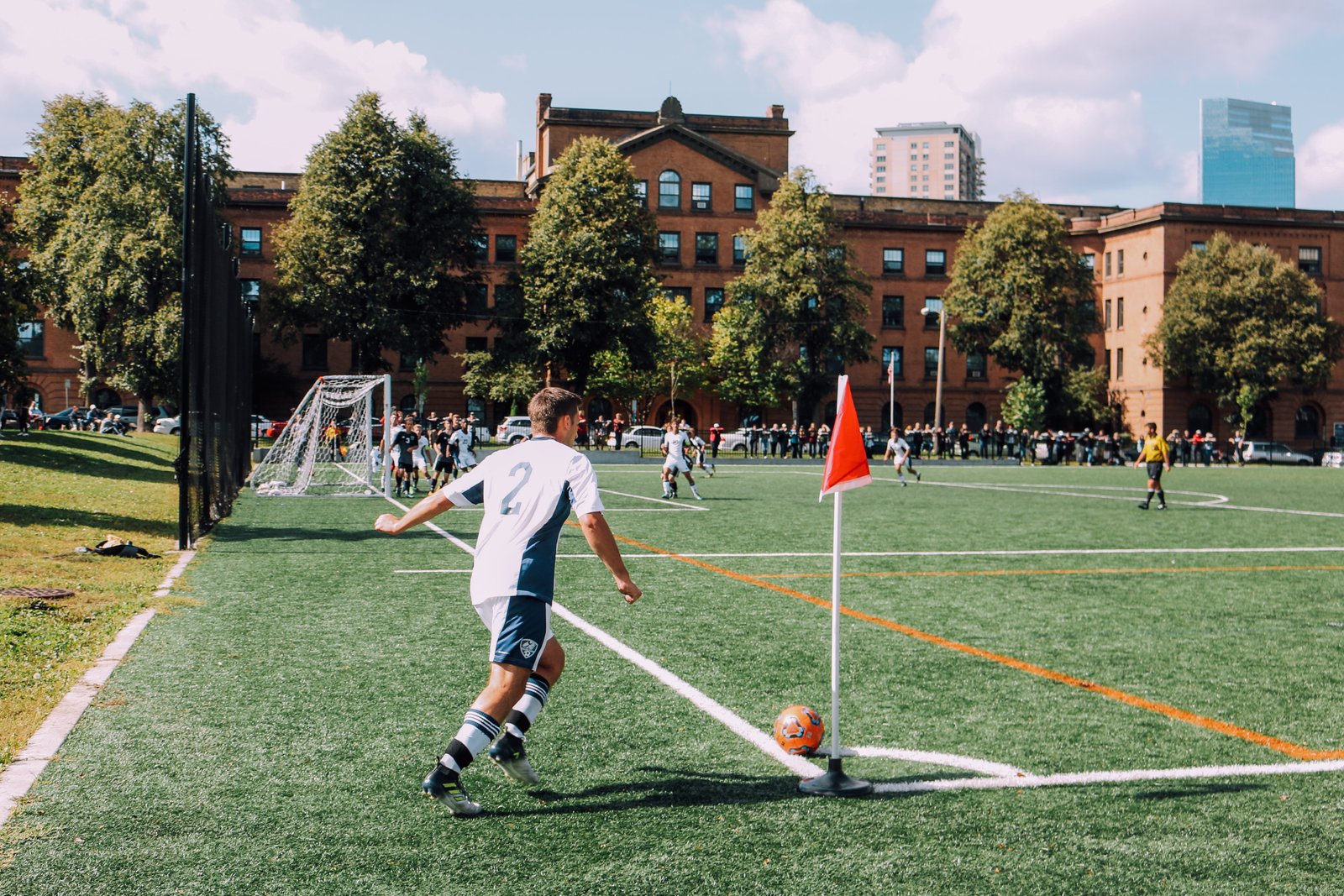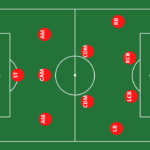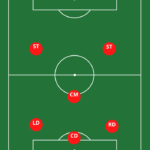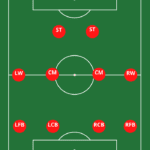- Last Updated -
Set Piece In Soccer, Let’s get started!
Soccer is a sport that requires both individual and team skills. A slice of its teamwork comes in the form of set pieces – an integral part of the game.
Set pieces in soccer are moments when play stops, and the ball is restarted under specific conditions. Whether it’s a free kick, corner kick, or throw-in, set pieces provide teams with a chance to strategize and execute pre-planned moves that can often lead to crucial goals.
Definition of a Set Piece in Soccer
A set piece in soccer is any restart where play stops and starts again under specific conditions. The game restarts after an infringement has occurred – like a foul or ball going out of bounds – giving the opposing team a chance to score or create potential goal-scoring opportunities. Free kicks, corner kicks, and throw-ins are all examples of set pieces.
Set pieces provide tactical opportunities for teams – they offer scenarios where it’s possible to execute pre-planned moves for either defensive or attacking purposes. Teams prepare for these moments by developing strategies that aim to take advantage of their opponent’s weaknesses while minimizing their own vulnerabilities.
Importance of Set Pieces in Soccer
Set pieces can have significant impacts on the outcome of games; they’re often responsible for some critical goals scored during high-level matches. It’s not uncommon for soccer players to practice set-piece routines repeatedly during training because they understand how important they are. For example, if you’re watching a match where both teams struggle to score from open play, set pieces will become more critical as they provide opportunities for goals when other options seem unavailable.
Many successful teams understand the importance of set-pieces; Liverpool FC under Jurgen Klopp is known as one such team that excels at corner kicks. On average, Liverpool scores one goal every four corners, making them one of the best-set piece teams in the world.
Set pieces are an essential aspect of soccer that can be the difference between victory and defeat. Teams that prepare properly for these scenarios increase their chances of success during a game.
Types of Set Pieces
Set pieces are crucial in soccer because they are opportunities to score goals or create scoring chances. There are three types of set pieces in soccer: corner kicks, free kicks, and throw-ins. Each type presents unique opportunities and challenges for teams to capitalize on.
Corner Kicks
Corner kicks are awarded when the defending team touches the ball over their own goal line. The attacking team then takes a corner kick from the corner nearest where the ball went out of play. Corner kicks can be a great way for teams to score goals, as they allow for players to get into scoring positions and head or shoot the ball toward the goal.
When it comes to taking corner kicks, there are a variety of strategies that teams can use. Some teams prefer to hit the ball high into the box for their tall players to head toward the goal, while others may prefer a low-driven cross aimed at players running onto it at the edge of the box.
It is also common for teams to have designated players who specialize in taking corner kicks due to their accuracy and ability to create dangerous chances. Key players involved in taking corner kicks include those with height and heading ability such as central defenders or forwards, as well as midfielders who possess excellent crossing abilities.
Free Kicks
Free kicks are awarded when a foul is committed by one team against another. The fouled team then takes a free kick from where the foul occurred on the pitch.
Free kicks can be taken directly at the goal or used as an opportunity to create scoring chances through crosses or passes. There are different types of free kicks that teams may use depending on their position on the pitch and proximity to the goal.
For example, direct free kicks allow players to strike the ball directly towards the goal with power and accuracy while indirect free kicks require a pass before a shot can be taken. Techniques for taking free kicks can vary, but players often use a variety of approaches such as swinging their leg through the ball with power or using finesse to place the ball into the corner of the net.
Throw-Ins
Throw-ins are awarded when the ball goes out of play on the touchline. The team that did not touch the ball last takes a throw-in from where it went out of play.
Throw-ins can be used to create attacking opportunities by allowing players to get into advanced positions on the pitch. Some rules and regulations govern how throw-ins must be taken, such as keeping both feet on the ground and throwing the ball from behind your head.
Strategies for taking throw-ins may include quickly throwing long balls downfield to catch defenders off guard or using short throws to maintain possession and build up play. Set pieces provide valuable opportunities for teams to score goals or create scoring chances.
Each type presents unique challenges and strategies for teams to capitalize on these chances. Understanding how each type works and utilizing different strategies can greatly benefit a team’s performance in soccer matches.
Set Piece Tactics
Set Piece Routines and Plays
Set pieces in soccer are an essential part of the game, and they can often be the deciding factor in a match. Set-piece routines refer to the pre-planned plays that teams execute during free kicks, corner kicks, throw-ins, and other similar situations. These plays are designed to create scoring opportunities or to disrupt the opposing team’s defense.
One example of a well-known set-piece routine is the “wall pass” maneuver used by Barcelona FC. In this move, Lionel Messi passes the ball into space just beyond a wall of his teammates who stand together as if forming a human barrier.
As soon as Messi makes the pass, he runs around the wall and receives it again from his teammate on the other side. This confuses defenders who lose track of Messi’s movement and creates space for him to make a shot on goal.
How Teams Practice Set Pieces
Professional soccer teams practice their set pieces regularly during training sessions. Coaches will often use tactics boards or videos to explain specific routines they want their players to execute during games.
Teams also analyze their opponent’s strengths and weaknesses in defending set pieces so that they can tailor their tactics accordingly. Practicing set pieces involves working on both offensive and defensive strategies.
Offensively, players practice executing different plays from different angles while trying to maintain spacing and timing. Defensively, players learn how to mark opposing players effectively while maintaining good positioning.
Examples of Set-Piece Tactics Used by Professional Teams
Some professional teams have become renowned for their innovative use of set-piece tactics during games. For example, Liverpool FC under Jurgen Klopp has developed an effective routine for taking corner kicks called “the short corner”.
In this strategy, instead of taking a conventional long cross into the box from a corner kick, Liverpool’s players pass the ball short to a teammate who is waiting just outside the box. This creates space for that player to take a shot on goal or to make a cross into the box from a different angle.
Another team that has become known for its successful use of set-piece tactics is Tottenham Hotspur under Mauricio Pochettino. In their routine called “the double bluff”, Spurs players form a wall in front of the opposing team’s defenders as if they are preparing for a direct shot on goal.
But instead, one of the players runs around the wall and receives a pass from another teammate who was hidden behind it. This disorients defenders and often creates scoring chances for Tottenham.
Set-piece tactics play an essential role in modern soccer games, and teams must practice them effectively to achieve success on the field. By working on innovative routines and plays, teams can create scoring opportunities or disrupt opponents’ defenses during free kicks, corner kicks, throw-ins, and other similar situations during gameplay.
Set Piece Specialists
In soccer, a set piece specialist is a player whose primary strength lies in executing set plays such as free kicks and corners with accuracy and effectiveness. These players are crucial to any team’s success as they can provide valuable scoring opportunities.
Set pieces require precision, strategy, and timing to execute well. Set-piece specialists have the knowledge and expertise to make the most out of these opportunities.
Role of a Set Piece Specialist
The role of a set-piece specialist is to create goal-scoring opportunities from dead-ball situations. They are responsible for taking free kicks or corner kicks that give their team an advantage over the opposition.
The specialist must understand the game’s dynamics and be able to read the match flow accurately. They should know when it’s best to take a shot on target or deliver a quality cross into the box.
Having an excellent set-piece specialist on your team can change everything during important matches. They can produce goals and help their team secure wins against even tough opposition.
Qualities that make a good Set Piece Specialist
The best set-piece specialists have certain innate qualities that make them excel in this area of soccer; they possess exceptional ball control skills, technical ability, creativity, vision, accuracy, power, and finesse. In addition to these traits, good communication skills are also essential for any successful set-piece specialist since they need to communicate effectively with other players on their team during the play execution phase.
Confidence is crucial for any player who wants to take on this role successfully. A confident player knows when it’s appropriate to pull off complex moves or shots during high-pressure matches.
Famous Set Piece Specialists in soccer history
Several great footballers specialized in taking free-kicks throughout history. David Beckham was one of the most famous set-piece specialists who could pinpoint his delivery accurately. His curling free kicks were a nightmare for any goalkeeper.
Cristiano Ronaldo is another great set-piece specialist. He developed his signature knuckleball technique that left everyone stunned, scoring several goals from impossible angles.
In the past, Roberto Carlos was a specialist in taking long free-kicks with tremendous power and swerve. Juninho Pernambucano, who played for Lyon and Brazil, was another free-kick master who could score from almost anywhere on the pitch.
Having a set-piece specialist on your team can be a game-changer since they can offer scoring opportunities that would have otherwise gone missing. Successful set-piece specialists possess unique qualities such as technical ability, creativity, accuracy, power, and finesse; they possess excellent communication skills and are confident in their abilities to execute plays successfully.

Conclusion
Summary of the importance and impact of set pieces in soccer
Set pieces are a crucial aspect of soccer games that can make all the difference between winning and losing. Corner kicks, free kicks, and throw-ins are all forms of set pieces that teams can use to their advantage. The ability to execute these set pieces effectively can turn a mediocre team into a championship contender.
Set piece situations provide unique opportunities for players to showcase their skills and allow coaches to strategize. One way set pieces affect the game is by creating scoring opportunities.
Statistics show that up to 40% of goals scored in professional soccer games come from set piece situations. Additionally, teams can use well-executed set-piece routines or plays to take advantage of weaknesses in their opponent’s defenses, leading to more scoring chances.
Future developments and innovations in set-piece tactics
As technology advances, so do the tactics used in soccer. In recent years, the development of video-assisted referees (VAR) has had a significant impact on how teams approach penalty kicks during games.
With more accurate decisions being made by referees with access to instant replays, players need to be more strategic when taking penalty kicks. Moreover, some forward-thinking coaches are incorporating new technology into their training regimes for set pieces such as virtual reality simulations.
These tools enable teams to practice various scenarios virtually before trying them on the field, which leads them better prepared and equipped during matches. With this in mind, it’s clear that we can expect further developments and innovations within this area soon which will continue making an impact on teams’ performance.
Set pieces have always been an integral part of football matches beyond just scoring goals – they offer unique tactical opportunities for both offensive and defensive strategies.
However, there is still much room for innovation concerning training techniques used for executing these critical parts of football. While no doubt set pieces will continue to play a significant role in football games, the potential for new technology and tactics to impact the game provides an exciting prospect for fans of the sport. (1)
What is the hardest position in soccer to play?
What is The Hardest Position in Soccer Importance of understanding positions in...
Read MoreWhat is a Soccer Assist?
The Importance of Teamwork in Soccer The importance of teamwork in soccer...
Read MoreBest Goalkeeper Gloves 2024
What are the best goalkeeper gloves? When it comes to soccer equipment,...
Read MoreUnderstanding the 4-5-1 Soccer Formation
The Importance of Understanding the Formation Soccer is a tactical sport, and...
Read MoreWhat is the best soccer position to play?
What is the best soccer position? Soccer is a sport that requires...
Read MoreWhat is Soccer Relegation?
Introduction: Exploring the World of Soccer relegation Soccer is one of the...
Read MoreWhat is a cap in soccer?
If you're a soccer fan, you've probably heard the term "cap" being...
Read MoreSoccer vs Football Field – A Tale of Two Fields
Comparing the Corners: Soccer Field Vs Football Field Shapes Let's talk a...
Read MoreBest Indoor Soccer Shoes 2024
Indoor soccer has been gaining popularity over the years, with more and...
Read MoreHandball Rule In Soccer – Law #12
Soccer is one of the most popular sports globally, with millions of...
Read Moresoccer position numbers quick guide
Each player on the field has an important job as it relates...
Read MoreSoccer Substitution Rules: The Strategic Art of Changing the Game
Soccer, known as the beautiful game worldwide, has seen various changes to...
Read MoreDominate the Field With The 4-2-3-1 Soccer Formation
Soccer is a dynamic game that constantly evolves, and its tactics are...
Read MoreSoccer History USA: From Struggles to Successes
Soccer, also known as football, is the world's most popular sport, with...
Read More5-3-2 Soccer Formation: History and Tactics
Are you a soccer enthusiast looking to understand the tactical intricacies that...
Read MoreSoccer Overtime Rules: Everything You Need to Know
Introduction: Overtime Soccer Rules Everything You Need To Know Soccer is a...
Read MoreMastering Soccer Outside Back Position: Tips and Techniques
Soccer is a dynamic sport, and the outside back position is no...
Read MoreThe Mercy Rule In Soccer And The Roll It Plays
Picture this: a soccer match, with one team dominating the field and...
Read MoreSoccer Position Abbreviations – A Beginners Guide
Hey there! You've landed on "Decoding Soccer Positions: A Rookie's Handbook". This...
Read MoreBest Soccer Cleats for Flat Feet 2024
Unlock your soccer potential and tap into the game-changing secret: the ultimate...
Read MoreBest Youth Soccer Cleats for 2024 : Top 5 Pick
Welcome to our comprehensive guide on the best youth soccer cleats for...
Read MoreBox-to-Box Center Midfielder: The Engine of Modern Soccer Teams
Soccer is a game of skill, strategy, and teamwork. Every player has...
Read MoreBest Soccer Cleat Insoles 2024
What are the Best Insoles For Soccer Cleat? Are you a serious...
Read MoreBest Soccer Cleats for Turf 2024
What are the Best Soccer Cleats for Turf Fields? Look no further...
Read MoreSoccer’s Attacking Midfielder And The Crucial Role It Plays
The attacking midfielder position in soccer is a vital role that requires...
Read MoreBreaking Down the False 9 Soccer Position
The false 9 position is a term used in soccer to describe...
Read MoreThe Sweeper Soccer Position: A Versatile and Dynamic Role
The sweeper position was popularized in the 1960s and 70s by the...
Read MoreThe Role of a Center Defensive Midfielder
The Backbone of the Team: The Role of a Center Defensive Midfielder...
Read MoreSoccer Halftime: How Long Is It?
Halftime in FIFA and MLS matches is a fixed duration of 15...
Read MoreBest Grip Socks For Soccer 2025
In this post, we present the best grip socks for soccer, so...
Read MoreSoccer Corner Kick – Soccer Law #17
A corner kick is a type of free-kick that is awarded to...
Read MoreSoccer Yellow Card … What Does It Mean?
Yellow cards are used to maintain order and fairness on the soccer...
Read MoreUnderstanding the Six Soccer Defensive Positions
In this article, focused on six defensive positions: goalkeeper (GK), sweeper (SW),...
Read MoreThe Highest Scoring Games In Soccer History
Phew, after reading about the seven worst blowouts in soccer history, I...
Read MoreThe Power of a Goal in Soccer, How it Influences The Game
Football, commonly known as soccer, has established itself as a globally renowned...
Read MoreMastering the 4-3-3 Soccer Formation
Here Are Some Teams That Have Mastered the 4-3-3 Soccer Formation -...
Read More7v7 Soccer Formations
Choosing the right 7v7 soccer formation is crucial for success on the...
Read MoreMastering the 4-4-2 Soccer Formation
The 4-4-2 soccer formation is one of the most popular formations used...
Read MoreCan Soccer Cleats Be Used For Baseball?… Pros and Cons…
Soccer and baseball are two different sports that require specific types of...
Read More






































